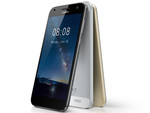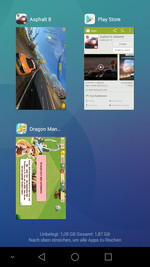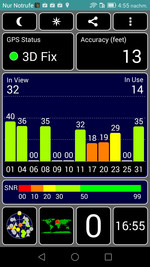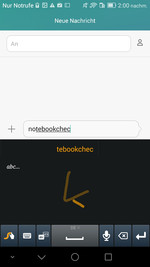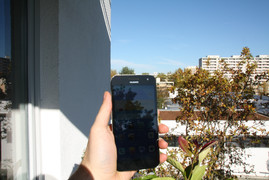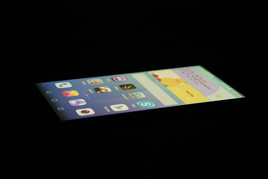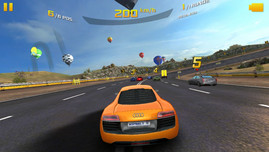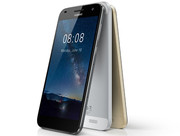Huawei Ascend G7 Smartphone Review

For the original German article, see here.
Huawei's Ascend G7 is the third smartphone with a 5.5-inch screen that we have tested in the past few months. There was the Ascend G730, followed by the Ascend G750, and now we have the Ascend G7. What are the differences? One is certainly the Ascend G7's metal casing; another is the LTE module that is installed in the Ascend G7. The current price difference between the Ascend G7 and Ascend G750 is just under 70 Euros (~$87). We will clarify whether the Ascend G7 is a real bargain in this report.
Other comparison devices are the Sony Xperia T3, HTC Desire 816, LG G Pro Lite Dual D686, and Samsung Galaxy Note 3 Neo.
Case
The metal casing of Huawei's Ascend G7 is truly a unique selling point in this price range. Plastic prevails among the comparison devices; even in the more expensive Samsung Galaxy Note 3 Neo, where polycarbonate is the tradition. Only Sony's Xperia T3 has metal parts to offer. The Ascend G7 feels rock-solid despite its large casing, and cannot be warped. On the other hand, it does not cope quite as well with pressure from the back or on the screen. This is visible in the screen's liquid crystals.
Huawei's Ascend G7 is the slimmest device among the competitors at 7.6 millimeters (~0.3 inches). Sony's Xperia T3 is right on its heels with only 0.1 millimeter more. LG's G Pro Lite Dual D686 is the bulkiest, with 9.64 millimeters (~0.38 inches). Huawei speaks of an "unbelievable body/screen ratio", i.e. the screen is framed by a very thin bezel. However, many other devices undercut that, such as Sony's Xperia T3 with a lower height and width.
Overall, Huawei has designed a good, yet not exactly lightweight casing at 165 grams (~5.8 ounces). Once again, Sony's Xperia T3 is the lightest at 148 grams (~5.2 ounces).
Only Samsung's Galaxy Note 3 Neo also has a 16 GB flash storage among the comparison devices, otherwise 8 GB is the standard. Not every competitor is equipped with an LTE Wi-Fi module either, and at a first glance, the cameras seem to have a fairly high-resolution with 13 megapixels on the rear and 5 megapixels on the front. The near field communication standard (NFC) and wireless display support are not installed.
The physical interfaces are smartphone standard, with a micro-USB 2.0 port and a 3.5 mm combo audio jack.
Software
Android 4.4.4 is the foundation for the software. Huawei covers it with its Emotion UI 3.0. This additional interface actually provides some useful extensions and innovations. For example, there is a quick access bar on the lock screen with a design that resembles Apple's iOS 8. It allows selecting another lock screen picture or to freeze it. Four apps can also be accessed directly.
The notification center has been completely revamped, and displays messages in a stylish yet not always very clearly arranged timeline. App logos are displayed with rounded corners, the user can choose designs, and there are some other minor modifications. Basically, every Android-veteran will find their way around quickly.
A few handy apps are preloaded, for example the phone manager that can free storage capacity, detect security risks, and block messages and calls from annoying people. There is a mirror app that utlizies the front-facing camera, and the screen can even be made "misty" when the user blows into the microphone. Fortunately, there is barely any bloatware on the smartphone.
Communication & GPS
It is helpful that the Ascend G7 features LTE support. It enables setting up high-speed Internet connections when the network and the user's mobile service plan permit. Five different frequency bands are supported. In addition, the smartphone communicates with LTE Cat. 4, which makes maximum download speeds of 15 Mbit per second and 50 Mbit per second in upload possible. We had a good signal in the poorly developed E-Plus UMTS network in an urban area during our test.
Wi-Fi supports the most common 802.11 b/g/n standards. The reception at a distance of 10 meters (~33 ft) from the router, and through three walls was very good. Full signal was displayed and websites loaded very quickly.
The GPS module also supports the Russian GLONASS network. We did not have any reception with it indoors, but we were tracked with an accuracy of four meters (~13 ft) after a short time in the outdoors.
Telephone and Voice Quality
The phone app's looks have been modified slightly, but still largely corresponds to the standard Android app. It is possible to create groups and select favorites, write short messages directly from the phone app, or to filter displayed contacts. It is also possible to access the settings directly, and for example, create blacklists for unwanted callers.
The voice quality is compelling. The contact occasionally sounded somewhat tinny, but was otherwise very clear and close. We were also clearly perceptible to our contact, though the lack of background noise suppression was criticized because we did not sound quite as close.
Cameras and Multimedia
Huawei's Ascend G7 stands out from the masses with its 13-megapixel rear-facing, and 5-megapixel front-facing cameras. Only HTC's Desire 816 can keep up with this. However, we complained about its lack of focus and image dynamics. This cannot be said about the Ascend G7. The pictures even look razor-sharp, and the colors are reproduced very accurately. However, bright areas tend to overexpose. The iPhone 6 does a considerably better job in this respect. Pictures shot without flash quickly start to develop noise, but the camera still does a satisfactory job overall.
The 5-megapixel front-facing camera is clearly aimed at selfie fans among smartphone buyers, and produces decent pictures. They are absolutely suitable for social media and Internet purposes, and even provides enough details for printing standard-sized pictures.
Input Devices and Controls
The keyboard comes from the maker of the popular "Swype" keyboard app, and thus has also been dubbed "Swype for Huawei". Subjectively, we like the standard Android keyboard better because it is more clearly arranged and does not look quite as cluttered. In addition, the keys are somewhat narrow in portrait mode. On the other hand, it must be noted that Swype offers a multitude of settings. Almost everything, starting with keyboard's height on the screen up to the font size of suggested words, can be set. It is also possible to make voice dictations or handwritten inputs by swiping over the keyboard. Users who do not like the keyboard anyway can simply switch back to the standard keyboard, or search for an alternative in the Play Store.
Making inputs on the Ascend G7 is very pleasant too. The touchscreen is sensitive up to its edges and responds accurately. There are extensive options for movement control, and it is even possible to use the touchscreen with thin gloves. Users with small hands can enable "single-hand control", which moves the controls to either the right or left edge of the screen for easier accessibility.
Display
You would actually think that a Full HD resolution should be standard for a 5.5-inch screen size. However, the device's low price comes into play, which only allows a resolution of 1280x720 pixels in most comparison devices. The Ascend G7 also competes with this resolution. Even LG's G Pro Lite Dual D686 has only 960x540 pixels.
The brightness of the screens in the comparison range is generally quite high, and the screen in Huawei's Ascend G7 also has a relatively high brightness with an average of 451 cd/m². The fairly high black level of 0.73 cd/m² is not as good, and causes black areas to look dark-gray. However, the illumination of 91% is very even.
| |||||||||||||||||||||||||
Brightness Distribution: 91 %
Center on Battery: 446 cd/m²
Contrast: 611:1 (Black: 0.73 cd/m²)
ΔE ColorChecker Calman: 5.72 | ∀{0.5-29.43 Ø4.79}
ΔE Greyscale Calman: 6.16 | ∀{0.09-98 Ø5}
Gamma: 2.19
CCT: 7699 K
| Huawei Ascend G7 Adreno 306, 410 MSM8916, 16 GB eMMC Flash | Huawei Ascend G730 Mali-400 MP2, MT6582, 4 GB Flash | Huawei Ascend G750 Mali-450 MP4, MT6592, 8 GB SSD | Samsung Galaxy Note 3 Neo N7505 Mali-T624, 5260 Hexa, 16 GB eMMC Flash | Sony Xperia T3 Adreno 305, 400 MSM8928, 8 GB SSD | LG Optimus G Pro Lite Dual D686 SGX531, MT6577, 8 GB SSD | HTC Desire 816 Adreno 305, 400 MSM8928, 8 GB SSD | |
|---|---|---|---|---|---|---|---|
| Screen | 8% | 1% | -4% | 3% | 21% | 10% | |
| Brightness middle (cd/m²) | 446 | 565 27% | 412 -8% | 351 -21% | 521 17% | 409 -8% | 431 -3% |
| Brightness (cd/m²) | 451 | 522 16% | 384 -15% | 357 -21% | 504 12% | 360 -20% | 423 -6% |
| Brightness Distribution (%) | 91 | 85 -7% | 85 -7% | 88 -3% | 89 -2% | 79 -13% | 87 -4% |
| Black Level * (cd/m²) | 0.73 | 0.71 3% | 0.52 29% | 0.77 -5% | 0.32 56% | 0.55 25% | |
| Contrast (:1) | 611 | 796 30% | 792 30% | 677 11% | 1278 109% | 784 28% | |
| Colorchecker dE 2000 * | 5.72 | 6.47 -13% | 6.71 -17% | 5.43 5% | 5.73 -0% | 5.13 10% | 5.66 1% |
| Greyscale dE 2000 * | 6.16 | 6.02 2% | 6.6 -7% | 4.84 21% | 6.83 -11% | 5.16 16% | 4.23 31% |
| Gamma | 2.19 100% | 2.28 96% | 2.62 84% | 2.42 91% | 3.46 64% | 2.34 94% | 2.31 95% |
| CCT | 7699 84% | 7905 82% | 8169 80% | 7762 84% | 8370 78% | 7090 92% | 7120 91% |
* ... smaller is better
Despite the relatively large screen and the comparatively low resolution of 720p, images look quite sharp on the screen of Huawei's Ascend G7. However, the colors could be slightly brighter. Huawei at least offers the option of adapting the color temperature to personal preferences. The cool color impression is due to the low contrast in the comparison field of 611:1, and the bluish cast that the screen exhibits.
We discovered this while analyzing the screen with the CalMAN software and a special measuring device. The bluish cast becomes visible even to the naked eye, particularly in the grayscale. Here, primarily the light gray colors and pure white are affected. This does not have such an impact on bold colors; they cover fairly accurately the reference rates of the sRGB color space. The bluish cast can be reduced even further via the manual color temperature control.
The screen's high brightness contributes to the legibility of contents, even on sunny days. However, this is no longer possible in direct sunlight due to the glossy surface. There are no problems recognizing anything on the screen indoors or in the shade.
Performance
The Snapdragon 410 MSM8916 from Qualcomm has a 64-bit processor architecture, clocks with 1.2 GHz, and features four cores. It is allegedly both more energy-efficient, and stronger than the older Snapdragon 400 models that are, for example, installed in Sony's Xperia T3 and HTC's Desire 816. In fact, the comparison devices clearly lag behind in the synthetic benchmarks. Only Samsung's Galaxy Note 3 Neo and Huawei's Ascend G750 can keep up.
The Adreno 306 graphics solution is used. It achieves average results in the synthetic benchmarks, and is not noticeably faster than the former Adreno 305 in Sony's Xperia T3 and HTC's Desire 816. According to our synthetic benchmarks, the Ascend G7 belongs to the slower models when browsing on the Internet, but we hardly noticed that in practice.
The storage is also somewhat slower in general than in the comparison devices. The Ascend G7 can only prevail in random write access. Overall, the buyer gets a decent processor and graphics performance that, however, cannot really stand out from the comparison devices.
| 3DMark | |
| 1280x720 offscreen Ice Storm Unlimited Score (sort by value) | |
| Huawei Ascend G7 | |
| Huawei Ascend G730 | |
| Huawei Ascend G750 | |
| Samsung Galaxy Note 3 Neo N7505 | |
| Sony Xperia T3 | |
| LG Optimus G Pro Lite Dual D686 | |
| HTC Desire 816 | |
| 1280x720 offscreen Ice Storm Unlimited Graphics Score (sort by value) | |
| Huawei Ascend G7 | |
| Huawei Ascend G730 | |
| Huawei Ascend G750 | |
| Samsung Galaxy Note 3 Neo N7505 | |
| Sony Xperia T3 | |
| LG Optimus G Pro Lite Dual D686 | |
| HTC Desire 816 | |
| 1280x720 offscreen Ice Storm Unlimited Physics (sort by value) | |
| Huawei Ascend G7 | |
| Huawei Ascend G730 | |
| Huawei Ascend G750 | |
| Samsung Galaxy Note 3 Neo N7505 | |
| Sony Xperia T3 | |
| LG Optimus G Pro Lite Dual D686 | |
| HTC Desire 816 | |
| GFXBench 3.0 | |
| on screen Manhattan Onscreen OGL (sort by value) | |
| Huawei Ascend G7 | |
| Huawei Ascend G730 | |
| Samsung Galaxy Note 3 Neo N7505 | |
| Sony Xperia T3 | |
| HTC Desire 816 | |
| 1920x1080 1080p Manhattan Offscreen (sort by value) | |
| Huawei Ascend G7 | |
| Huawei Ascend G730 | |
| Samsung Galaxy Note 3 Neo N7505 | |
| Sony Xperia T3 | |
| HTC Desire 816 | |
| GFXBench (DX / GLBenchmark) 2.7 | |
| T-Rex Onscreen (sort by value) | |
| Huawei Ascend G7 | |
| Huawei Ascend G730 | |
| Huawei Ascend G750 | |
| Samsung Galaxy Note 3 Neo N7505 | |
| 1920x1080 T-Rex Offscreen (sort by value) | |
| Huawei Ascend G7 | |
| Huawei Ascend G730 | |
| Huawei Ascend G750 | |
| Samsung Galaxy Note 3 Neo N7505 | |
| Sunspider - 1.0 Total Score (sort by value) | |
| Huawei Ascend G7 | |
| Huawei Ascend G730 | |
| Huawei Ascend G750 | |
| Samsung Galaxy Note 3 Neo N7505 | |
| Sony Xperia T3 | |
| LG Optimus G Pro Lite Dual D686 | |
| HTC Desire 816 | |
| Octane V2 - Total Score (sort by value) | |
| Huawei Ascend G7 | |
| Huawei Ascend G730 | |
| Samsung Galaxy Note 3 Neo N7505 | |
| Sony Xperia T3 | |
| LG Optimus G Pro Lite Dual D686 | |
| HTC Desire 816 | |
| Mozilla Kraken 1.1 - Total (sort by value) | |
| Huawei Ascend G7 | |
| Huawei Ascend G730 | |
| Samsung Galaxy Note 3 Neo N7505 | |
| Sony Xperia T3 | |
| LG Optimus G Pro Lite Dual D686 | |
| HTC Desire 816 | |
* ... smaller is better
Games
Huawei's Ascend G7 did not have any problems presenting "Asphalt 8" almost lag-free even when the graphic settings were set to "high". Although the image is not quite as brilliant as in smartphones with a 1080p resolution, the game still looks very good - particularly when racing through Tokyo at night in the rain. The Ascend G7 can confidently be called gaming suitable because the controls via touchscreen and position sensor function quite well, and the smartphone did not have problems with other games from the Play Store. However, some games do not always run absolutely smoothly in ultra-high details.
Emissions
Temperature
The temperature development is pleasingly low. Huawei's Ascend G7 barely heats up with 35.1 degrees (~95 °F) maximum in load. The temperatures are even considerably lower while idling so that the device can be called very cool.
(+) The maximum temperature on the upper side is 35.1 °C / 95 F, compared to the average of 35.2 °C / 95 F, ranging from 21.9 to 247 °C for the class Smartphone.
(+) The bottom heats up to a maximum of 34.6 °C / 94 F, compared to the average of 34 °C / 93 F
(+) In idle usage, the average temperature for the upper side is 28.6 °C / 83 F, compared to the device average of 32.9 °C / 91 F.
Speakers
The speaker in the back's lower area gives a slightly overburdened impression when rendering rich sounds, such as multiple instruments playing simultaneously. The sound then quickly loses accuracy. Bass is non-existent, and trebles sound somewhat overemphasized. At least the speaker does not hum in maximum volume, and it is quite adequate for the audio playback of occasional Internet videos. Users who want a higher sound quality should use the 3.5 mm audio jack.
Energy Management
The battery capacity of Huawei's Ascend G7 is rather average with 11.1 Wh. However, Huawei manages to retrieve quite decent runtimes from that, and even outperforms most comparison devices. It is possible to browse on the Internet via Wi-Fi for 11:43 hours before the Ascend G7's battery is drained. Only Samsung's Galaxy Note 3 Neo achieved a longer time in the Wi-Fi test owing to its economic OLED screen.
| Huawei Ascend G7 Adreno 306, 410 MSM8916, 16 GB eMMC Flash | Huawei Ascend G730 Mali-400 MP2, MT6582, 4 GB Flash | Huawei Ascend G750 Mali-450 MP4, MT6592, 8 GB SSD | Samsung Galaxy Note 3 Neo N7505 Mali-T624, 5260 Hexa, 16 GB eMMC Flash | Sony Xperia T3 Adreno 305, 400 MSM8928, 8 GB SSD | LG Optimus G Pro Lite Dual D686 SGX531, MT6577, 8 GB SSD | HTC Desire 816 Adreno 305, 400 MSM8928, 8 GB SSD | |
|---|---|---|---|---|---|---|---|
| Battery runtime | -19% | -9% | -4% | -36% | -13% | -9% | |
| WiFi (h) | 11.7 | 10.3 -12% | 10.6 -9% | 13.4 15% | 10.6 -9% | 11.6 -1% | 11.4 -3% |
| Load (h) | 5.4 | 4 -26% | 4.2 -22% | 2 -63% | 4.1 -24% | 4.6 -15% |
Verdict
The metal casing of Huawei's Ascend G7 lets it stand out from the masses of not-quite-phablet smartphones for below 300 Euros (~$372). The build fits, the device is slim, and the communication modules have a good reception performance. The decent software with a multitude of options and the good cameras are also very convincing. Huawei's Ascend G7 does not have any real shortcomings in terms of screen, performance or battery life.
The value for money is just right in any case, even if the screen's black level could be higher, and the speaker's quality has room for improvement. However, real weaknesses will not be discovered in the Ascend G7 when considering the category standards. Consequently, the buyer will get a rock-solid mid-range device in the best sense.




